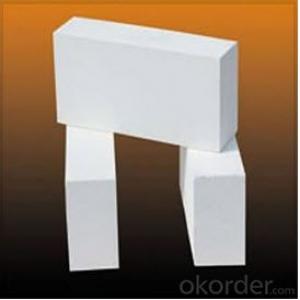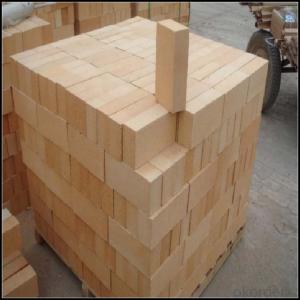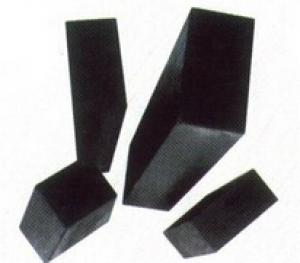High Alumina Brick - Insulating Fire Brick for Foundry Furnace
- Loading Port:
- Tianjin
- Payment Terms:
- TT OR LC
- Min Order Qty:
- 1 m.t.
- Supply Capability:
- 2000 m.t./month
OKorder Service Pledge
OKorder Financial Service
You Might Also Like
Description of High Alumina Brick
High Alumina Brick Insulating Fire Brick for Foundry Furnace is widely used in metallurgy, petroleum, chemical industry, building materials, machinery processing, military, etc of thermal technology equipment. High Alumina Brick is widely used for MgO Reduction Furnace, Blast furnace, Hot Blast Stove, Tunnel kiln , Steel Ladle, Steel smelting furnace, Coke oven,chimney, Waste incinerators, Casting products, Boilers, Cement kilns, Carbon furnace, Glass kilns and a variety of furnace linings and thermal equipment.etc.
Specifications for High Alumina Brick
Item | Fireclay brick | High Alumina Brick | ||||
SK32 | SK34 | SK35 | SK36 | SK37 | SK38 | |
Al2O3 (%) ≥ | 35 | 42 | 48 | 55 | 65 | 75 |
Refractoriness (oC) ≥ | 1670 | 1730 | 1750 | 1770 | 1790 | 1790 |
Refractoriness under Load, oC,0.2MPa ≥ | 1250 | 1300 | 1420 | 1470 | 1500 | 1520 |
Linear Change(%),oC×2h | 1350 | 1350 | 1450 | 1500 | 1500 | 1500 |
-0.5~0 | -0.5~0 | -0.4~+0.1 | -0.4~+0.1 | -0.4~+0.1 | -0.4~+0.1 | |
Porosity (%)≤ | 24 | 22 | 20 | 20 | 19 | 19 |
Cold Crushing Strength, MPa≥ | 20 | 30 | 39.2 | 44.1 | 49 | 53.9
|
Features of High Alumina Brick
Low thermal conductivity, good thermal insulation performance.
Long service life, easy operation, could be shaped freely
Product specification: standard form, normal standard, shaped and special shaped bricks.
Can be used in various kilns because of its cheapness and general tray package. Among all of the refractory materials, it is the most widely used.
Typical Application of High Alumina Brick
Furnaces of metallurgy industry, heat treatment furnace.
Furnaces of chemical industry and construction industry.
Furnace of incineration of garbage, recirculating fluidized bed furnace .




- Q: What are the high aluminum bricks made of?
- It's OK to use corundum bricks and alumina hollow ball bricks to build a furnace,
- Q: What are the reasons for the spalling of refractory bricks in the production of lime kiln?
- In the course of the production of lime kiln, the local block of refractory brick is a very dangerous signal. It is suggested that you stop the kiln to prevent the collapse of a large area. Lime kiln is the main equipment for the production of limestone kiln and rotary kiln is two, with the growth of calcium carbide lime kiln industry, iron and steel industry, the construction industry to the amount of limestone has become the main production equipment, and refractory bricks became the heart of lime kiln.
- Q: What are the specific raw materials for plastic pallets?
- There are two kinds of raw materials for plastic pallets: one is polypropylene (PP) and the other is polyethylene (HDPE).Plastic pallets for logistics storage: pp+pe material, recycled material 10%;Plastic trays for food trays: food grade PP, PE, pc;Polyethylene (HDPE) has excellent impact resistance and cold resistance, and it can resist environmental stress cracking. Excellent chemical stability, good oil resistance. Water absorption and tiny, low permeability, organic vapor transmission rate is larger. Electrical insulation is good, in all frequency range, dielectric properties are extremely excellent.
- Q: The difference between aluminium refractory and magnesia refractory
- Magnesia refractory belongs to alkaline refractory materials refers to refractory products such as magnesia magnesia brick magnesium iron spinel magnesium aluminum spinel magnesia ramming materials and other products of raw materials is the main crystal phase is periclase magnesia products
- Q: What's the price of high alumina refractory bricks?
- The price of high alumina refractory bricks varies greatly according to the content of AL2O3.
- Q: Aluminum content 38, silicon content 55 What refractory bricks?
- High alumina brick:The mineral composition of the high alumina brick is determined by the bauxite used. The mineral composition of the clinker is usually mullite, corundum and glass. The theoretical composition of mullite is Al2O371.8%, SiO2 28.2%, and its melting decomposition temperature is 1840 DEG C. With acicular crystal, network cross structure, high temperature state showed better strength. Corundum in the form of alpha -Al2O3, melting point of 2050 degrees, hardness of Mohs 9, showing a granular and columnar crystal, has good chemical stability, acid, alkaline slag have a certain resistance. Based on the composition of mullite minerals, the phase composition of high alumina brick can be judged according to the content of Al2O3. When the bricks are below Al2O3 71.8%, the base of the composition is mullite and SiO2, such as grade LZ-48 bricks. Because it contains a large number of SiO2 formed in the liquid phase under high temperature is 20% ~ 30%; brick in Al2O3 more than 71.8%, the excess Al2O3 formed corundum crystal under high temperature, while generating 2 high temperature phase, eutectic temperature rise by the low content of Al2O3 brick 1595 C to 1840 C, such as grade LZ-75 brick. In fact, it is impossible to produce a complete phase equilibrium in the process of production, but the glass phase is very small, and there is no more than 10% in the partial gap of the Yu Jing phase
- Q: Which is better, the soft core or the hard core?
- When the current through the wire, it will produce a magnetic field in the vertical plane space of the wire, if there is a current two wire close by in the same direction, because they produce a magnetic field in the direction is opposite, it will produce a repulsive force is due to the magnetic field force. They will mutually inhibit current intensity of the other party, caused by the reduction of current in the wire, this inhibition of each current intensity, we called wire inductance. When the AC current line frequency is high, the inductance is stronger.
- Q: The difference between ordinary and diatomite brick refractory brick
- Refractory brick belongs to a large class, according to different materials used are divided into: high alumina brick, dolomite brick, magnesia chrome brick, magnesia spinel brick, phosphate brick, carborundum brick, brick, mullite bricks etc..
- Q: What's the weight of the refractory bricks?
- Referred to as refractory brick. Refractory made from refractory clay or other refractory material. Light yellow or brownish. The utility model is mainly used for laying smelting furnaces, and can withstand high temperature between 1580 DEG C and 1770 DEG C. Also called brick. Refractory material of a certain shape and size. According to the preparation process can be divided into bricks, brick, electric melting brick, refractory insulating bricks (Rong Zhuzhuan);
- Q: The difference between clay bricks and clay bricks
- Clay brick is a small building with artificial bulk. Also called sintered brick. Solid clay brick is one of the oldest building materials in the world. It is a building material that is loved by the people.
Send your message to us
High Alumina Brick - Insulating Fire Brick for Foundry Furnace
- Loading Port:
- Tianjin
- Payment Terms:
- TT OR LC
- Min Order Qty:
- 1 m.t.
- Supply Capability:
- 2000 m.t./month
OKorder Service Pledge
OKorder Financial Service
Similar products
Hot products
Hot Searches
Related keywords




























